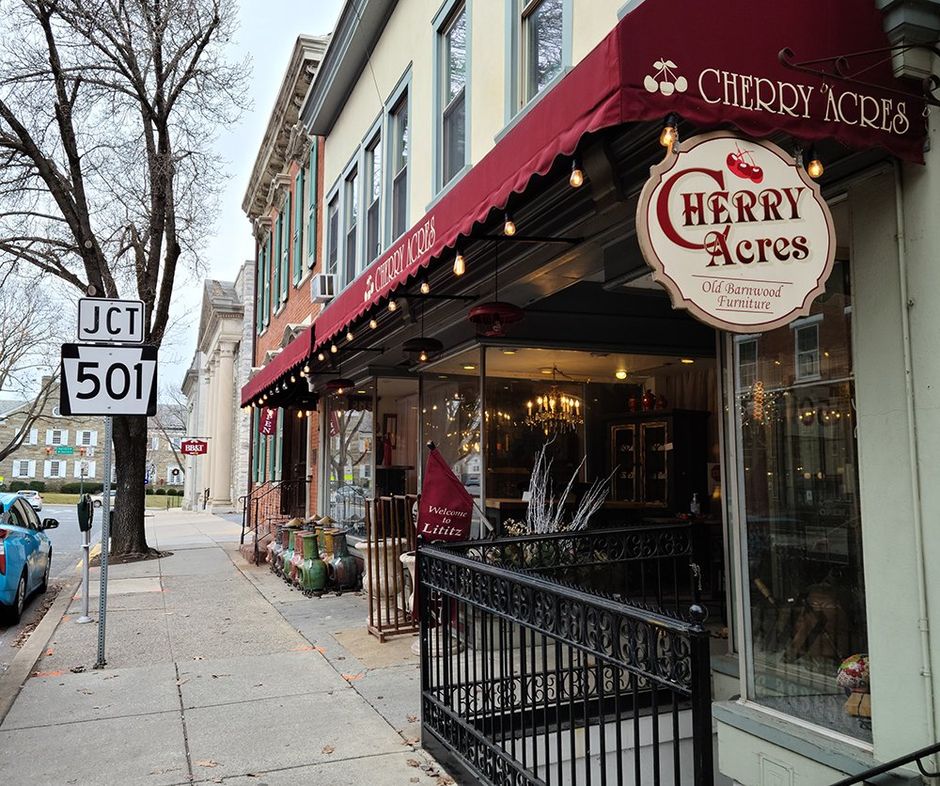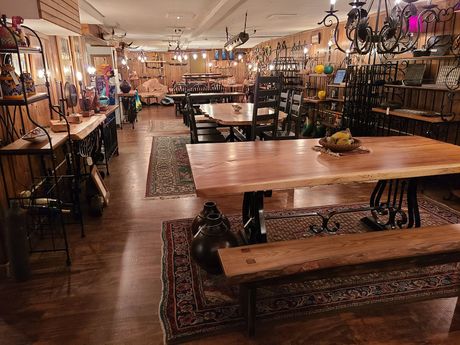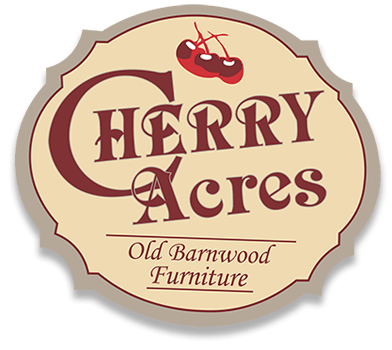
Slide title
Write your caption hereButton
Slide title
Write your caption hereButton
About us
At Cherry Acres we specialize in reclaimed barn wood custom furniture and live edge slabs.
Visit our Lititz store to see a large selection that is ever-changing with new pieces of Steampunk, Talavera, Live Edge end tables, tabletops, small to large dining sets! It is obvious that a lot of time is spent creating the perfect finish on the finished pieces, but we also offer unfinished pieces allowing you to give it that perfect touch to match your room.
- From Idea to Concept...
Craig Wolf from Lancaster County was in the business of tearing down old buildings and selling the lumber for extra money. Craig began picking out pieces he liked and started hand-crafting furniture. He made several pieces and found they were very popular at local shows. This side business began to grow quickly and he was traveling to shows from Massachusettes to Texas.
- Transformation from Old Wood to Finished Furniture
To create beautiful furniture from old wood, he hand selects wood that is chosen as reclaimed lumber, this wood can range from barn siding, to barn or house floors, to large beams and joists. The primary species used are pine, hemlock, and fir. These species, when naturally aged for 100 - 200 years in old buildings, give great character and originallity to the furniture.
- Enjoy Browsing Our Wide Selection...
When you visit the Lititz Store you will find a wide-selection from servers, kitchen islands, farm tables, benches, corner cabinets, to bedroom and bathroom pieces such as armoires to vanities.
- From Shows to Store Front
With the success of Craig's side furniture business growing, he decided to open a store where customers could browse comfortably. He found a shop on Main Street in Lititz, near the town square. As a result this business grew.
- With the Help of Local Amish...
In addition to our workshop , we work with a number of Pennsylvania Amish Craftsmen to make our furniture.
This joint effort offers furniture like Shutter Cabinets with Pennsylvania Dutch designs carved into the wood panels. Starting with old house shutters, we build the cabinets to fit the doors. Carvings are all hand-done by a local Amishman, whose wife also does our decorative painted pieces. This offers unique features with no two pieces being exactly alike!
- Unique Beauty, Hand-Crafted Character...
You will find pieces come available in natural stain, as well as a wide variety of paints with antique glazes. Each piece is handled with plenty of TLC from start to finish.
Another style that has made Cherry Acres popular is the selection of ornamental iron and pottery from Mexico. Mexican Talavera is an attractive look that offers unique features and beauty in sinks and home decor items. Another must see type of piece from Mexico is the ornamental iron and pottery.
SUSTAINABLE
Extraction & Production
Here is a short explanation of the extraction process, ensuring sustainability and legality of our practices. Feel free to share this information with anyone that is in question of our sustainability and our practices.
SUSTAINABLE
Extraction & Production
Here is a short explanation of the extraction process, ensuring sustainability and legality of our practices. Feel free to share this information with anyone that is in question of our sustainability and our practices.
Costa Rica has protected reserves and parks, 35% of the territory is untouchable.
ANY trees, even the ones of your backyards must get an authorization or permit to be cut. There is no "white cut" or concession in Costa Rica, only selective cutting on private land.
Any person who wants to cut a few trees on his property must ask for a study by a private Forestry engineer. This study is presented to the MINAE (Forestry Ministry). The MINAE sends their own engineer and reviews which trees they will authorize to cut, if you ask for 15, they authorize 10 for example. The rules are usually 3 trees authorized to cut per hectare (2.5 acres) for farmland. But they can give more if you are in some special areas, highly populated with trees to help to maintain the health of the forest.
After the study is done by the MINAE the owner of the land gets his license to cut.
You cut the trees authorized, and after you call again the ministry to review the land, all trees cut (or fallen) are reviewed by GPS. You cut ONE tree more than you are supposed to...3 to 5 years in jail, seized trucks, wood and all assets seized by the police.
After the trees are down, you call again the MINAE, they will give you tags for each log you want to remove, this is called a GUIA. So when all of your logs have tags, you can move them to the mill. The GUIAs are only good for 2 weeks at the time...it means you must move your wood in this period of time, after this date, if you did not move your wood, you must ask again for a GUIA from the MINAE. They do that to control perfectly the wood moving in the country.
If ONE log has no tag and you get caught with this log, again jail time.
You can only move your logs between 5am to 9pm, so any truck trying to move wood at night is arrested and, on the roads here, there are police stops that check all trucks moving during the night.
When the logs arrive at the mill, they give the GUIA to the owner of the mill, the inventory must be done and after that, at any time an inspector from MINAE can come to take the GUIA back and match with the original permit to cut, they inspect one or two times a week all mills. First, they ask for the new GUIAs and review the logs with their tags.
The MINAE reviews the new logs with tags, they mark all the new logs with their own logo (hammer the logo) and remove the tags (so you can't try to use them twice).
At any time if the MINAE gets ONE log without their logo mark, or new logs coming without a tag, the mill gets shut down.
When you export you must present the license to cut given to the owner of the land, the GUIA which is the authorization to move the wood, mill invoices (to avoid small mill cutting in the forest) and a kiln dryer license. After all of that you need an inspection by another organization before it goes for export, this is the MAG (Ministry of Agriculture).
When we export the wood, we always have a certificate of origin, to be able to get it, you need to present all those documents. Customs does not let the wood out unless you present your inspection documents made by the MAG (and of course the MAG asks you to provide the chain of origin to give you the authorization). Not easy to export from here, so moving illegal wood is practically impossible.
As you can understand Costa Rica is a leading country with maintaining its forest. Certification for Europe (for the chain of origin of the wood) is not needed for Costa Rica, they have a free trade treaty, and their sustainability has been demonstrated.
Altogether the deforestation rate of Costa Rica sits at 0%...one of the few countries in the world and the surface covered by trees at a recent estimate was 52%. As Costa Rica moves to a carbon neutral country by 2020 I would expect that they will continue to leverage their eco-sustainability so keeping our operation above ground and green as possible will help us all.
Costa Rica has protected reserves and parks, 35% of the territory is untouchable.
Second, ANY trees, even the one of your backyards must get an authorization or permit to be cut. There is no "white cut" or concession in Costa Rica, only selective cutting on private land.
Any person who wants to cut a few trees on ahis property must ask for a study by a private Forestry engineer. This study is presented to the MINAE (Forestry Ministry). The MINAE sends their own engineer and reviews which trees they will authorize to cut, if you ask for 15, they authorize 10 for example. The rules are usually 3 trees authorized to cut per hectare (2.5 acres) for farmland. But they can give more if you are in some special areas, highly populated with trees to help to maintain the health of the forest.
After the study is done by the MINAE the owner of the land gets his license to cut.
You cut the trees authorized, and after you call again the ministry to review the land, all trees cut (or fallen) are reviewed by GPS. You cut ONE tree more than you are supposed to...3 to 5 years in jail, seized trucks, wood and all assets seized by the police.
After the trees are down, you call again the MINAE, they will give you tags for each log you want to remove, this is called a GUIA. So when all of your logs have tags, you can move them to the mill. The GUIAs are only good for 2 weeks at the time...it means you must move your wood in this period of time, after this date, if you did not move your wood, you must ask again for a GUIA from the MINAE. They do that to control perfectly the wood moving in the country.
If ONE log has no tag and you get caught with this log, again jail time.
You can only move your logs between 5am to 9pm, so any truck trying to move wood at night is arrested and, on the roads here, there are police stops that check all trucks moving during the night.
When the logs arrive at the mill, they give the GUIA to the owner of the mill, the inventory must be done and after that, at any time an inspector from MINAE can come to take the GUIA back and match with the original permit to cut, they inspect one or two times a week all mills. First, they ask for the new GUIAs and review the logs with their tags.
The MINAE reviews the new logs with tags, they mark all the new logs with their own logo (hammer the logo) and remove the tags (so you can't try to use them twice).
At any time if the MINAE gets ONE log without their logo mark, or new logs coming without a tag, the mill gets shut down.
When you export you must present the license to cut given to the owner of the land, the GUIA which is the authorization to move the wood, mill invoices (to avoid small mill cutting in the forest) and a kiln dryer license. After all of that you need an inspection by another organization before it goes for export, this is the MAG (Ministry of Agriculture).
When we export the wood, we always have a certificate of origin, to be able to get it, you need to present all those documents. Customs does not let the wood out unless you present your inspection documents made by the MAG (and of course the MAG asks you to provide the chain of origin to give you the authorization). Not easy to export from here, so moving illegal wood is practically impossible.
As you can understand Costa Rica is a leading country with maintaining its forest. Certification for Europe (for the chain of origin of the wood) is not needed for Costa Rica, they have a free trade treaty, and their sustainability has been demonstrated.
Altogether the deforestation rate of Costa Rica sits at 0%...one of the few countries in the world and the surface covered by trees at a recent estimate was 52%. As Costa Rica moves to a carbon neutral country by 2020 I would expect that they will continue to leverage their eco-sustainability so keeping our operation above ground and green as possible will help us all.
Contact Us
Contact Us
We will get back to you as soon as possible
Please try again later




